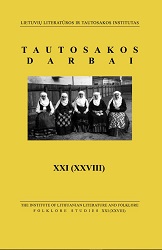FOLKLORINĖS PATIRTIES APRAIŠKOS GYVENIMO PASAKOJIMUOSE
MANIFESTATIONS OF THE FOLKLORIC EXPERIENCES IN THE LIFE STORIES
Author(s): Vilma DAUGIRDAITĖSubject(s): Cultural history, Customs / Folklore
Published by: Lietuvių literatūros ir tautosakos institutas
Keywords: Folkloristic experiences; folklore material; tradition; folk narrative; folk genres;
Summary/Abstract: In the process of folklore collection in various Lithuanian regions during the second half of the 20th century, quite a number of famous folklore informants were found; the folklore material submitted by many of them was peculiarly enriched by their autobiographical accounts, previously unprecedented in the verbal creativity neither by their contents nor form, yet now increasingly becoming subjects of the folkloristic scrutiny. In the focus of analysis of the present study, the life stories composed by two famous folklore informants (both females belonging to the same generation and representing the folk tradition of the same Lithuanian region) in the 1970s were placed. More detailed attention is paid in the article to the influence and role of the old classical folklore genres in shaping these narratives. The results of the analysis allow us asserting that the mode of the life story chosen by a good folklore informant reflects the kind of tradition its author represents, i.e. folksong or folk narrative; or, to put it more accurately, the folkloric experience of the folk singer or folk narrator subtly shapes the way of presentation / narration itself. Another side of this experience reveals itself when a proverb, a strophe from a song or a fragment of a tale is “fished out” from the memory along with a certain life event and is neatly incorporated into the life narrative as an inherent part of life. Compositions with folksong fragments woven into the narrative seem to be more frequent. Nevertheless, proverbs exercise almost unlimited possibilities of expressing both philosophical thoughts and pinpoint characterizations of individuals or social phenomena. On the other hand, the tendencies of using the old classical folklore genres in the life stories allow us to note the increasing gap between life and folklore in the second half of the 20th century.
Journal: Tautosakos darbai
- Issue Year: 2006
- Issue No: 32
- Page Range: 214-224
- Page Count: 11
- Language: Lithuanian

